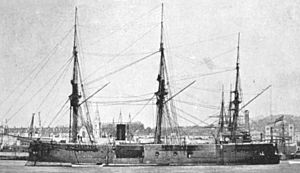HMS Pallas (1865) facts for kids
 |
|
Quick facts for kids History |
|
|---|---|
| Name | HMS Pallas |
| Builder | Woolwich Dockyard |
| Laid down | 19 October 1863 |
| Launched | 14 March 1865 |
| Completed | 6 March 1866 |
| Fate | Sold on 20 April 1886 |
| General characteristics | |
| Displacement |
|
| Length | 225 ft (69 m) |
| Beam | 50 ft (15 m) |
| Draught |
|
| Propulsion | Humphreys & Tennant compound horizontal I.H.P. = 3,580 |
| Sail plan | Ship-rigged, sail area 16,716 sq ft (1,553.0 m2) |
| Speed |
|
| Complement | 253 |
| Armament | |
| Armour | Belt, battery & bulkheads 4.5 inches (110 mm) |
HMS Pallas was a special warship built for the Royal Navy in the 1860s. It was unique because it had a wooden body but was covered with strong iron plates. This made it an "ironclad" ship. Pallas was designed by Sir Edward Reed. The Navy decided to build it to use up a lot of wood they had at the Woolwich Dockyard.
Contents
Building and Design of HMS Pallas
A New Kind of Warship
Pallas was built as a "centre battery ship." This means its main guns were placed in a strong, armored section in the middle of the ship. It had two big guns on each side. It also had other guns at the very front (bow) and back (stern) of the ship. These were called "chase guns" and were used when chasing or being chased by an enemy.
Guns and Ramming Power
The guns in the middle could even turn to fire forwards or backwards through special openings. However, moving these heavy guns in rough seas would have been very dangerous. Pallas did not have many guns, but its main weapon was supposed to be a "ram." A ram was a strong, pointed part at the front of the ship. The idea was to crash into enemy ships and sink them!
New Engines and Speed
Pallas was the first Royal Navy warship to use special "compound expansion engines." These engines were expected to make the ship very fast. The designers hoped it could reach 14 knots (about 26 kilometers per hour). This speed was important for ramming enemy ships that were also moving.
On its first tests, Pallas only reached about 12.5 knots. After some changes to its front shape, it managed to reach 13 knots. This speed was still not quite enough to easily ram other fast enemy ships. However, other ships with similar speeds were able to ram enemies in real battles. This showed that even a slightly slower ramming ship could still be dangerous if used cleverly.
Service History of HMS Pallas
Early Years and Fire
HMS Pallas officially started its service at Portsmouth. On October 31, 1868, a fire broke out on board while the ship was in Gibraltar. Seventeen crew members were hurt. Luckily, a warship from the United States Navy helped put out the fire.
Fleet Service and Retirement
After the fire, Pallas served with the Channel Fleet until September 1870. Then, it was taken out of service for a long time to be repaired and updated. From 1872 to 1879, it joined the Mediterranean Fleet. After this, it was taken out of active service again. Pallas was kept in reserve at Devonport until it was finally sold on April 20, 1886.

